 Books that allow readers to see themselves and the ways they think and live are often popular with young readers since it’s important for them to figure out all the ways that they can be true to themselves. It’s vital that books feature individuals just like them as well as others who are quite different from them. As what they know of the world becomes larger, it’s increasingly important for young readers to read books that highlight the ways in which they are alike and different from individuals from across the globe. The best multicultural books allow readers to stretch the borders of their world, providing passports to fascinating places and ways of living as well as offering insight into how someone right next door or someone thousands of miles away may think and live. By identifying commonalities and celebrating differences, these multicultural books foster understanding. ReadWriteThink offers a wide range of lesson plan ideas and activities dealing with diversity and the use of multicultural books for all grade levels.
Books that allow readers to see themselves and the ways they think and live are often popular with young readers since it’s important for them to figure out all the ways that they can be true to themselves. It’s vital that books feature individuals just like them as well as others who are quite different from them. As what they know of the world becomes larger, it’s increasingly important for young readers to read books that highlight the ways in which they are alike and different from individuals from across the globe. The best multicultural books allow readers to stretch the borders of their world, providing passports to fascinating places and ways of living as well as offering insight into how someone right next door or someone thousands of miles away may think and live. By identifying commonalities and celebrating differences, these multicultural books foster understanding. ReadWriteThink offers a wide range of lesson plan ideas and activities dealing with diversity and the use of multicultural books for all grade levels.
GRADES K-3
Bates, Katharine Lee. (2013). America, the Beautiful: Together we stand. Orchard Books.
 Ten American artists pay tribute to the beloved patriotic song "America the Beautiful" in this lovely picture book. Several distinctive artistic interpretations of the song’s lyrics and their connections to this nation are woven into the title through the illustrations of Bryan Collier, Raul Colon, Diane Goode, Mary Grandpre, John Hendrix, Yuyi Morales, Jon J. Muth, LeUyen Pham, Sonia Lynn Sadler, and Chris Soentpiet. It's interesting to compare and contrast the images as well as the lyrics that accompany them. Additionally, inspiring presidential quotes from Thomas Jefferson, Barack Obama, George Washington, Franklin D. Roosevelt, and Theodore Roosevelt, among others, are included. Back matter provides additional information about the national symbols, one of which is included on every double-page spread. Providing a fresh perspective on history, this picture book reminds readers of the bonds that unite the inhabitants of this diverse country. Chris Soentpiet is the speaker at the Book and Author Luncheon at the 2013 IRA Annual Convention in San Antonio. Read more about him on Reading Today Online and the Engage blog.
Ten American artists pay tribute to the beloved patriotic song "America the Beautiful" in this lovely picture book. Several distinctive artistic interpretations of the song’s lyrics and their connections to this nation are woven into the title through the illustrations of Bryan Collier, Raul Colon, Diane Goode, Mary Grandpre, John Hendrix, Yuyi Morales, Jon J. Muth, LeUyen Pham, Sonia Lynn Sadler, and Chris Soentpiet. It's interesting to compare and contrast the images as well as the lyrics that accompany them. Additionally, inspiring presidential quotes from Thomas Jefferson, Barack Obama, George Washington, Franklin D. Roosevelt, and Theodore Roosevelt, among others, are included. Back matter provides additional information about the national symbols, one of which is included on every double-page spread. Providing a fresh perspective on history, this picture book reminds readers of the bonds that unite the inhabitants of this diverse country. Chris Soentpiet is the speaker at the Book and Author Luncheon at the 2013 IRA Annual Convention in San Antonio. Read more about him on Reading Today Online and the Engage blog.
- Barbara A. Ward, Washington State University Pullman
The Global Fund for Children. (2013). Global baby girls. Watertown, MA: Charlesbridge.
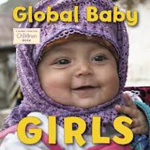 The Global Fund for Children has produced several wonderful books for young children including Global Babies in 2006 and American Babies in 2010. This new addition to the series focuses on girls around the world. Full color photographs with baby girls in their native clothing present an emphasis on what girls can do. From countries as diverse as Russia, New Zealand, Liberia, India, Peru, France, China, Guatemala, Canada and the United States, the world of the importance of young girls is visually brought to our youngest readers through this beautifully presented board book. Learn more about The Global Fund for Children and see some of the internal art for this book at their website.
The Global Fund for Children has produced several wonderful books for young children including Global Babies in 2006 and American Babies in 2010. This new addition to the series focuses on girls around the world. Full color photographs with baby girls in their native clothing present an emphasis on what girls can do. From countries as diverse as Russia, New Zealand, Liberia, India, Peru, France, China, Guatemala, Canada and the United States, the world of the importance of young girls is visually brought to our youngest readers through this beautifully presented board book. Learn more about The Global Fund for Children and see some of the internal art for this book at their website.
- Karen Hildebrand, Ohio Library and Reading Consultant
Jiang, Ji-li. (2013). Red kite, blue kite. Illus. by Greg Ruth. New York: Disney/Hyperion Books.
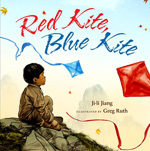 From the author of the critically acclaimed, Red Scarf Girl, the memoir of her own experience surviving the Cultural Revolution in China, author Ji-Li Jiang brings a picture-book story of young Tai Shan and his father during this same time period. They have enjoyed flying their kites together at every opportunity until the time when the men in red armbands come and take father away to a labor camp. Tai Shan is sent to live with Granny Wang, but Baba has devised a kite-flying code for Tai Shan so they can send messages through their red and blue kites. Each day Tai Shan waits so see his father’s kite soaring high, letting his son know that he continues to be safe in the labor camp. A scary time comes for Tai when the kite is no longer flying. The watercolor illustrations of Greg Ruth provide a colorful backdrop to this story as the red and blue of the kites represent hope throughout this story. The author has provided historical notes at the end.
From the author of the critically acclaimed, Red Scarf Girl, the memoir of her own experience surviving the Cultural Revolution in China, author Ji-Li Jiang brings a picture-book story of young Tai Shan and his father during this same time period. They have enjoyed flying their kites together at every opportunity until the time when the men in red armbands come and take father away to a labor camp. Tai Shan is sent to live with Granny Wang, but Baba has devised a kite-flying code for Tai Shan so they can send messages through their red and blue kites. Each day Tai Shan waits so see his father’s kite soaring high, letting his son know that he continues to be safe in the labor camp. A scary time comes for Tai when the kite is no longer flying. The watercolor illustrations of Greg Ruth provide a colorful backdrop to this story as the red and blue of the kites represent hope throughout this story. The author has provided historical notes at the end.
- Karen Hildebrand, Ohio Library and Reading Consultant
MacLachlan, Patricia. (2013). Nora’s chicks. Illus. by Kathryn Brown. Somerville, MA: Candlewick Press.
 Based on the author’s grandmother’s immigrant experience, award-winning author Patricia MacLachlan writes about the new life for Nora and her family as they arrive from Russia to the American prairie. Nora and her younger brother Milo are having a tough time adjusting to their new life. Papa is busy with the farm and getting their new life and farm settled into American life. The stray dog that wanders into the farm seems to like Milo better than Nora. Papa brings home ten chicks and two geese, thinking more of eggs and a possible dinner or two, and they become Nora’s responsibility. She immediately takes on the care of her new animal friends and they follow her everywhere … even to church. She begs Papa to let her keep them because they are just too beautiful to eat. Through her funny little entourage, Nora gains the friendship of a young neighbor girl, Susannah. Brown’s watercolor illustrations bring out the dusty colors of the prairie but also the beauty of the Russian background of the main characters. Through slight text and enjoyable illustrations young readers will get a sense of early life on the American prairie through the eyes of the immigrant experience. Read an interview with the award-winning author about this book at the blog, Two Writing Teachers.
Based on the author’s grandmother’s immigrant experience, award-winning author Patricia MacLachlan writes about the new life for Nora and her family as they arrive from Russia to the American prairie. Nora and her younger brother Milo are having a tough time adjusting to their new life. Papa is busy with the farm and getting their new life and farm settled into American life. The stray dog that wanders into the farm seems to like Milo better than Nora. Papa brings home ten chicks and two geese, thinking more of eggs and a possible dinner or two, and they become Nora’s responsibility. She immediately takes on the care of her new animal friends and they follow her everywhere … even to church. She begs Papa to let her keep them because they are just too beautiful to eat. Through her funny little entourage, Nora gains the friendship of a young neighbor girl, Susannah. Brown’s watercolor illustrations bring out the dusty colors of the prairie but also the beauty of the Russian background of the main characters. Through slight text and enjoyable illustrations young readers will get a sense of early life on the American prairie through the eyes of the immigrant experience. Read an interview with the award-winning author about this book at the blog, Two Writing Teachers.
- Karen Hildebrand, Ohio Library and Reading Consultant
Mora, Pat. (2012). The beautiful lady: Our Lady of Guadalupe. Illus. by Steve Johnson and Lou Fancher. New York: Knopf.
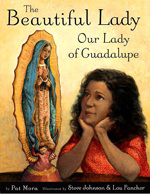 Although this religious story has been told many times, author Pat Mora and illustrators Johnson and Fancher put a beautiful new touch to the age-old story. This fresh approach opens as two little girls are looking at a statue of the Virgin Mary and ask, “Who is that pretty lady?” Grandma Lupita becomes the storyteller to relive the spiritual appearance of Our Lady of Guadalupe who appears to the Mexican villager, Juan Diego, in the year 1531. She asks Juan to speak to the bishop and ask that he build her a church. The bishop is doubtful and asks for proof of the lady’s request. When Juan Diego shows the bishop the roses that are blooming through the snow and the Lady’s image embedded onto his cloak the bishop is convinced. Mora has included a detailed author’s note about this moment in religious history and the influence of the Lady of Guadalupe today. Author Pat Mora’s website, Bookjoy, has numerous activities and background information to use with this book.
Although this religious story has been told many times, author Pat Mora and illustrators Johnson and Fancher put a beautiful new touch to the age-old story. This fresh approach opens as two little girls are looking at a statue of the Virgin Mary and ask, “Who is that pretty lady?” Grandma Lupita becomes the storyteller to relive the spiritual appearance of Our Lady of Guadalupe who appears to the Mexican villager, Juan Diego, in the year 1531. She asks Juan to speak to the bishop and ask that he build her a church. The bishop is doubtful and asks for proof of the lady’s request. When Juan Diego shows the bishop the roses that are blooming through the snow and the Lady’s image embedded onto his cloak the bishop is convinced. Mora has included a detailed author’s note about this moment in religious history and the influence of the Lady of Guadalupe today. Author Pat Mora’s website, Bookjoy, has numerous activities and background information to use with this book.
- Karen Hildebrand, Ohio Library and Reading Consultant
Seto, Loretta. (2013). Mooncakes. Illus. by Renee Benoit. Victoria, BC: Orca Book Publishers.
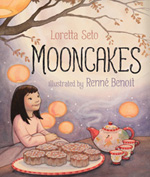 A young girl and her family share simple family traditions while celebrating the Chinese Moon Festival. As they enjoy treats typically associated with the special day, including mooncakes and tea poured from an elegant tea spout, life seems to slow down long enough for all three of them to savor these special moments spent together. As often happens during family gathers, her parents tell three different traditional tales about the moon. At the conclusion of each story, the child peers at the moon to see the characters featured, for instance, the jade rabbit. This simple story features evocative language while noting how the family eats the mooncakes that are "round like the moon. They make a circle for me and Mama and Baba" (unpaged) as they peer up into the night sky together. The illustrations are filled with scenes of quiet celebration and soft colors.
A young girl and her family share simple family traditions while celebrating the Chinese Moon Festival. As they enjoy treats typically associated with the special day, including mooncakes and tea poured from an elegant tea spout, life seems to slow down long enough for all three of them to savor these special moments spent together. As often happens during family gathers, her parents tell three different traditional tales about the moon. At the conclusion of each story, the child peers at the moon to see the characters featured, for instance, the jade rabbit. This simple story features evocative language while noting how the family eats the mooncakes that are "round like the moon. They make a circle for me and Mama and Baba" (unpaged) as they peer up into the night sky together. The illustrations are filled with scenes of quiet celebration and soft colors.
- Barbara A. Ward, Washington State University Pullman
Shewchuk, Pat. (2013). In Lucia’s neighborhood. Illus. by Marek Colek. Toronto, Ontario, CA: Kids Can Press.
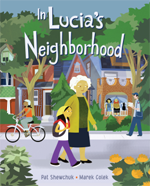 Teachers looking for books that share the neighborhood atmosphere, this book along with the short animated film it is based on (Montrose Avenue, 2006) will find this book helpful. Based on Little Portugal in Toronto, Canada, Lucia’s grandmother tells her about Jane Jacobs, an urban planner and environmental activist whose opening quote sets the tone for the book, “The ballet of the good city sidewalk never repeats itself from place to place, and in any one place is always replete with new improvisations.” Though teachers will have to prepare to explain and work with this quote it does guide the tour that Lucia takes readers on as she introduces all the aspects of her neighborhood. Digitally rendered illustrations reflect all the activity throughout Lucia’s environs. Teachers will enjoy The Very Hungy Bookworm blog that highlights this book on the Cultural Diversity Saturday feature or learn more about the film Montrose Avenue.
Teachers looking for books that share the neighborhood atmosphere, this book along with the short animated film it is based on (Montrose Avenue, 2006) will find this book helpful. Based on Little Portugal in Toronto, Canada, Lucia’s grandmother tells her about Jane Jacobs, an urban planner and environmental activist whose opening quote sets the tone for the book, “The ballet of the good city sidewalk never repeats itself from place to place, and in any one place is always replete with new improvisations.” Though teachers will have to prepare to explain and work with this quote it does guide the tour that Lucia takes readers on as she introduces all the aspects of her neighborhood. Digitally rendered illustrations reflect all the activity throughout Lucia’s environs. Teachers will enjoy The Very Hungy Bookworm blog that highlights this book on the Cultural Diversity Saturday feature or learn more about the film Montrose Avenue.
- Karen Hildebrand, Ohio Library and Reading Consultant
Snyder, Laurel. (2013). The longest night: A Passover story. Illus. by Catia Chien. New York: Schwartz & Wade.
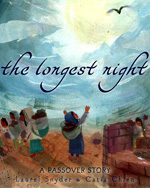 Narrated through rhyming text in the voice of a young slave girl child and illustrated with dark acrylic paintings, the story of Passover is told for young readers. In an author’s note, Snyder explains that she always wondered what the children were doing during this time of the Jews enslaved in Egypt 3500 years ago. From that wondering, she wrote her representation of how she thinks their Exodus transpired. The young girl featured in the story begins with the drudgery her life is entrenched with in carrying stone to build other people’s homes. Then the 10 plagues arrive and her life begins to change as the Jews escape the results of plague, frogs, fleas, illness to first-born children, and other disasters that were befalling the non-Jews of Egypt. As she and her mother flee through the sea that has split into two, they are elated to find their freedom. This beautiful picture book presents the Exodus from Egypt that young children can understand. Read an interview with the author about writing this book.
Narrated through rhyming text in the voice of a young slave girl child and illustrated with dark acrylic paintings, the story of Passover is told for young readers. In an author’s note, Snyder explains that she always wondered what the children were doing during this time of the Jews enslaved in Egypt 3500 years ago. From that wondering, she wrote her representation of how she thinks their Exodus transpired. The young girl featured in the story begins with the drudgery her life is entrenched with in carrying stone to build other people’s homes. Then the 10 plagues arrive and her life begins to change as the Jews escape the results of plague, frogs, fleas, illness to first-born children, and other disasters that were befalling the non-Jews of Egypt. As she and her mother flee through the sea that has split into two, they are elated to find their freedom. This beautiful picture book presents the Exodus from Egypt that young children can understand. Read an interview with the author about writing this book.
- Karen Hildebrand, Ohio Library and Reading Consultant
Stier, Catherine. (2013). Welcome to America, Champ! Illus. by Doris Ettlinger. Ann Arbor, MI: Sleeping Bear Press.
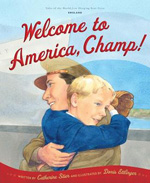 As WWII ends Thomas, his mother, and his new baby brother leave their home in England to join his new family in the United States. Thomas's stepfather is a soldier, and while Thomas looks forward to his new life in Chicago, he is anxious about what things will be like in his new school and new home. Before leaving his familiar surroundings, he questions his stepfather about what things are like in the United States, and takes notes on scraps of paper to help him navigate a new world. While he draws strength from the notes, he also helps encourage an anxious young fellow passenger with a special gift that has given him encouragement. The softly-colored illustrations and inviting text pay tribute to war brides and their families and the sacrifices they made in coming to America. Young readers will quickly identify with Thomas’s mingled fears and excitement as they realize that moving to a new country offers challenges as well as hope for the future. Although readers may know about the existence of war brides, they are unlikely to realize that there were so many of them and that the movement of these women to their new homes was known as "Operation Diaper Run." Filled with colorful illustrations and text, the book effectively evokes the particular time when citizens across the world celebrated the end of a bloody war. That universal feeling of hope pulses through this title.
As WWII ends Thomas, his mother, and his new baby brother leave their home in England to join his new family in the United States. Thomas's stepfather is a soldier, and while Thomas looks forward to his new life in Chicago, he is anxious about what things will be like in his new school and new home. Before leaving his familiar surroundings, he questions his stepfather about what things are like in the United States, and takes notes on scraps of paper to help him navigate a new world. While he draws strength from the notes, he also helps encourage an anxious young fellow passenger with a special gift that has given him encouragement. The softly-colored illustrations and inviting text pay tribute to war brides and their families and the sacrifices they made in coming to America. Young readers will quickly identify with Thomas’s mingled fears and excitement as they realize that moving to a new country offers challenges as well as hope for the future. Although readers may know about the existence of war brides, they are unlikely to realize that there were so many of them and that the movement of these women to their new homes was known as "Operation Diaper Run." Filled with colorful illustrations and text, the book effectively evokes the particular time when citizens across the world celebrated the end of a bloody war. That universal feeling of hope pulses through this title.
- Barbara A. Ward, Washington State University Pullman
Thong, Roseanne. (2013). Round is a tortilla: A book of shapes. Illus. by John Parra. San Francisco: Chronicle Books.
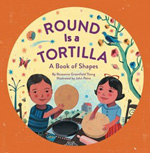 Primary teachers that like to use picture books to teach early elements of geometry and want to thread a multicultural element into their math classrooms will appreciate this book. Beginning with “Round are sombreros./ Round is the moon./ Round are the trumpets/ that blare out a tune” (p.1) the rhyming text continues to point out things in a child’s life that take on various shapes. After several pages of one shape, the concluding page asks, “I can name more round things. Can you?” (p.5) The next shape is square, then rectangle, on to triangles, ovals and stars. For each shape, Spanish words are embedded in the narrative and illustrator John Parra’s illustrations offer vibrant pictures of Hispanic culture. Visit the author’s website for other things this multicultural author has written.
Primary teachers that like to use picture books to teach early elements of geometry and want to thread a multicultural element into their math classrooms will appreciate this book. Beginning with “Round are sombreros./ Round is the moon./ Round are the trumpets/ that blare out a tune” (p.1) the rhyming text continues to point out things in a child’s life that take on various shapes. After several pages of one shape, the concluding page asks, “I can name more round things. Can you?” (p.5) The next shape is square, then rectangle, on to triangles, ovals and stars. For each shape, Spanish words are embedded in the narrative and illustrator John Parra’s illustrations offer vibrant pictures of Hispanic culture. Visit the author’s website for other things this multicultural author has written.
- Karen Hildebrand, Ohio Library and Reading Consultant
Tonatiuh, Duncan. (2013). Pancho Rabbit and the coyote: A migrant’s tale. New York: Abrams.
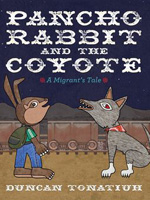 Young Pancho Rabbit cannot wait for his father's return from his work in the fields, and when he doesn't arrive on the expected date, he sets off to find him. He meets a coyote who offers to help him, but he must give the coyote and others along the route everything he has. After crossing the desert, Pancho has nothing else to offer the greedy coyote. Just as the animal advances on Pancho, his Papa arrives. The hand-drawn, digitally collaged illustrations are likely to appeal to the eyes of young readers, who will quickly recognize that the story is an allegory for the frequent traffic across the border between Mexico and the United States as men, women, and children rely on coyotes for aid in their crossing as they seek economic opportunities. The back matter details the numbers of immigrants from the country’s southern border and the difficulties experienced by the families left behind. This picture book is sure to open the eyes of many to their plight and possibly serve as food for discussion.
Young Pancho Rabbit cannot wait for his father's return from his work in the fields, and when he doesn't arrive on the expected date, he sets off to find him. He meets a coyote who offers to help him, but he must give the coyote and others along the route everything he has. After crossing the desert, Pancho has nothing else to offer the greedy coyote. Just as the animal advances on Pancho, his Papa arrives. The hand-drawn, digitally collaged illustrations are likely to appeal to the eyes of young readers, who will quickly recognize that the story is an allegory for the frequent traffic across the border between Mexico and the United States as men, women, and children rely on coyotes for aid in their crossing as they seek economic opportunities. The back matter details the numbers of immigrants from the country’s southern border and the difficulties experienced by the families left behind. This picture book is sure to open the eyes of many to their plight and possibly serve as food for discussion.
- Barbara A. Ward, Washington State University Pullman
Wade, Mary Dodson. (2013). No year of the cat. Illus. by Nicole Wong. Ann Arbor, MI: Sleeping Bear Press.
 The emperor is troubled by the fact that people cannot remember the years, especially the years of great events. He comes up with an idea to have a race. “The first twelve animals to cross the great river will each have a year named for them. With the years so named, we can remember when auspicious events occurred” (p.5). And so the race is on. Knowing that they are smaller and weaker and stand no chance of swimming across the river, Rat and Cat convince Ox to carry them on his back. As the water rushes past, Rat shoves Cat off, and when they reach the far shore, Rat jumps from Ox and is the first to win the race. Ox becomes the next to finish, followed by Tiger, Rabbit, Dragon, Horse, Monkey, Rooster, Sheep, Dog, and Pig. When Cat comes running up to find where he placed, the Emperor tells him he did not finish in time. From that time on, cats have never trusted rats and take every opportunity to catch them! This is one of many variants of an ancient Chinese tale. Enjoy a detailed teaching guide for this book at the publisher’s website.
The emperor is troubled by the fact that people cannot remember the years, especially the years of great events. He comes up with an idea to have a race. “The first twelve animals to cross the great river will each have a year named for them. With the years so named, we can remember when auspicious events occurred” (p.5). And so the race is on. Knowing that they are smaller and weaker and stand no chance of swimming across the river, Rat and Cat convince Ox to carry them on his back. As the water rushes past, Rat shoves Cat off, and when they reach the far shore, Rat jumps from Ox and is the first to win the race. Ox becomes the next to finish, followed by Tiger, Rabbit, Dragon, Horse, Monkey, Rooster, Sheep, Dog, and Pig. When Cat comes running up to find where he placed, the Emperor tells him he did not finish in time. From that time on, cats have never trusted rats and take every opportunity to catch them! This is one of many variants of an ancient Chinese tale. Enjoy a detailed teaching guide for this book at the publisher’s website.
- Karen Hildebrand, Ohio Library and Reading Consultant
Yamasaki, Katie. (2013). Fish for Jimmy: Inspired by one family’s experience in a Japanese American internment camp. New York: Holiday House.
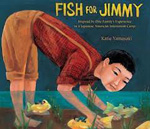 Based on this debut author/illustrator’s family experience, this moving picture book relates the story of one family’s internment as Japanese Americans at a camp in Colorado during World War II. After the Japanese attack on the U.S. Naval Base at Pearl Harbor, Taro’s father is taken away for questioning by the FBI. Taro, his mother, and his younger brother Jimmy are sent to the internment camp for imprisonment. Jimmy is despondent and will not eat. Everything is so different in the camp and he misses his father. Taro comes up with a plan to help his brother. Through vivid stylistic acrylic illustrations, young readers will watch Taro sneak his mother’s scissors into a scarf, and stealthily avoid the camp guards and spotlights, to cut a hole in the barbed wire fence and escape. Searching in a dark forest that he does not know, he comes upon a stream and is able to catch some fish. Returning to camp the same way, he gives his mother the fish to cook for Jimmy just the way they had eaten when they were together as a family before the war. An author’s note at the end gives details of her family’s experience at the Granada Relocation Center in Colorado that includes archival photographs of the period. Visit the author’s website to view some of her beautiful murals and other artwork.
Based on this debut author/illustrator’s family experience, this moving picture book relates the story of one family’s internment as Japanese Americans at a camp in Colorado during World War II. After the Japanese attack on the U.S. Naval Base at Pearl Harbor, Taro’s father is taken away for questioning by the FBI. Taro, his mother, and his younger brother Jimmy are sent to the internment camp for imprisonment. Jimmy is despondent and will not eat. Everything is so different in the camp and he misses his father. Taro comes up with a plan to help his brother. Through vivid stylistic acrylic illustrations, young readers will watch Taro sneak his mother’s scissors into a scarf, and stealthily avoid the camp guards and spotlights, to cut a hole in the barbed wire fence and escape. Searching in a dark forest that he does not know, he comes upon a stream and is able to catch some fish. Returning to camp the same way, he gives his mother the fish to cook for Jimmy just the way they had eaten when they were together as a family before the war. An author’s note at the end gives details of her family’s experience at the Granada Relocation Center in Colorado that includes archival photographs of the period. Visit the author’s website to view some of her beautiful murals and other artwork.
- Karen Hildebrand, Ohio Library and Reading Consultant
GRADES 4-5
Farhana, Zia. (2013). The garden of my Imam. Atlanta: Peachtree Publishers.
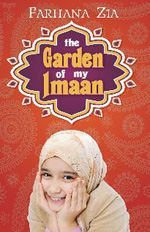 Fifth grader Aliyah loves her family and her religion, but she feels too uncomfortable about her own place in the school's pecking order to embrace openly her Muslim faith and cultural identity. In fact, when the school principal suggests that she befriend Marwa, a new girl from Morocco who is also Muslim, she avoids the girl as much as possible. Over time, though, as she works on a project for her religion class and watches how comfortable Marwa is with her own self-identity, Aliyah begins to speak up for herself and her beliefs, taking risks and embracing the possibilities that come her way. She experiences bullying and prejudice in all sorts of forms, from an adult shouting ethnic slurs at her mother for almost causing an accident to classmates who seem only to see the hijab worn by Marwa and not the girl beneath the scarf to those who lump all Muslims together. Certain to prompt healthy discussions about the dilemmas faced by Aliyah and Marwa, this title provides an honest approach to issues that many boys and girls Aliyah's age must face. Despite the serious nature of the issues, the book also contains many humorous passages.
Fifth grader Aliyah loves her family and her religion, but she feels too uncomfortable about her own place in the school's pecking order to embrace openly her Muslim faith and cultural identity. In fact, when the school principal suggests that she befriend Marwa, a new girl from Morocco who is also Muslim, she avoids the girl as much as possible. Over time, though, as she works on a project for her religion class and watches how comfortable Marwa is with her own self-identity, Aliyah begins to speak up for herself and her beliefs, taking risks and embracing the possibilities that come her way. She experiences bullying and prejudice in all sorts of forms, from an adult shouting ethnic slurs at her mother for almost causing an accident to classmates who seem only to see the hijab worn by Marwa and not the girl beneath the scarf to those who lump all Muslims together. Certain to prompt healthy discussions about the dilemmas faced by Aliyah and Marwa, this title provides an honest approach to issues that many boys and girls Aliyah's age must face. Despite the serious nature of the issues, the book also contains many humorous passages.
- Barbara A. Ward, Washington State University Pullman
Moss, Marissa. (2103). Barbed wire baseball. Illus. by Yuko Shimizu. New York: Abrams.
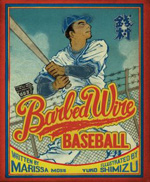 This inspiring story of bravery and perseverance highlights the determination of one man to find a way to endure his internment in a camp during WWII. As in the case for 100,000 American citizens of Japanese descent, Kenichi (Zeni) Zenimura and his family are imprisoned because the United States government feared that they would spy for Japan. This book describes how the baseball-loving Zeni makes the best of an impossible situation, and painstakingly builds a baseball field inside the internment camp in Gila River, Arizona. His careful attention to detail as he removes rocks from the field, levels the field, and plants seeds to cover the infield are vivid examples of how much Zeni loves the game and its ability to transcend barriers. By the time readers reach the final pages of the book, they will be cheering alongside all the interned citizens inside the camp's barriers. The text will engage readers while the illustrations, created with a Japanese calligraphy brush and ink and then scanned and colored with Adobe Photoshop, highlight the whole community’s involvement in one man's project. Pair this title with Baseball Saved Us (1995, Lee and Low) by Ken Mochizuki and So Far from the Sea (1998, Clarion) by Eve Bunting. Young readers will enjoy seeing three photographs of the diminutive Zeni, one taken next to the massive Babe Ruth, and learning the story behind this story. While small in stature, this man clearly was much larger than life. Read more about author Marissa Moss in "Bringing the 'Story' Back Into 'History'" on the Engage blog.
This inspiring story of bravery and perseverance highlights the determination of one man to find a way to endure his internment in a camp during WWII. As in the case for 100,000 American citizens of Japanese descent, Kenichi (Zeni) Zenimura and his family are imprisoned because the United States government feared that they would spy for Japan. This book describes how the baseball-loving Zeni makes the best of an impossible situation, and painstakingly builds a baseball field inside the internment camp in Gila River, Arizona. His careful attention to detail as he removes rocks from the field, levels the field, and plants seeds to cover the infield are vivid examples of how much Zeni loves the game and its ability to transcend barriers. By the time readers reach the final pages of the book, they will be cheering alongside all the interned citizens inside the camp's barriers. The text will engage readers while the illustrations, created with a Japanese calligraphy brush and ink and then scanned and colored with Adobe Photoshop, highlight the whole community’s involvement in one man's project. Pair this title with Baseball Saved Us (1995, Lee and Low) by Ken Mochizuki and So Far from the Sea (1998, Clarion) by Eve Bunting. Young readers will enjoy seeing three photographs of the diminutive Zeni, one taken next to the massive Babe Ruth, and learning the story behind this story. While small in stature, this man clearly was much larger than life. Read more about author Marissa Moss in "Bringing the 'Story' Back Into 'History'" on the Engage blog.
- Barbara A. Ward, Washington State University Pullman
Whelan, Gloria. (2013). In Andal's house. Ann Arbor, MI: Sleeping Bear Press.
 The best student in his class in Gujarat, India, Kumar is excited to be invited to watch the fireworks for Dijali at his classmate Andal's house. But once he arrives, his friend’s grandmother refuses to let him stay because his family is considered one of the untouchables. Kumar is understandably disappointed and upset, and his enjoyment of the sights, sounds, and tastes of the festivities is spoiled because of this slight. His grandfather provides a glimpse of hope, though, as he reminds Kumar of the progress that the nation has already made toward equity and his expectations that it will continue to make because of changing attitudes. Back matter includes a glossary of unfamiliar terms. The richly-hued illustrations almost exude the scent and taste of the foods and the sounds of the busy street. Books for children that address economic and social class inequities are rare to find, making this one an excellent addition to the class library. For more about this author, read "5 Questions With...Gloria Whelan" on the Engage blog.
The best student in his class in Gujarat, India, Kumar is excited to be invited to watch the fireworks for Dijali at his classmate Andal's house. But once he arrives, his friend’s grandmother refuses to let him stay because his family is considered one of the untouchables. Kumar is understandably disappointed and upset, and his enjoyment of the sights, sounds, and tastes of the festivities is spoiled because of this slight. His grandfather provides a glimpse of hope, though, as he reminds Kumar of the progress that the nation has already made toward equity and his expectations that it will continue to make because of changing attitudes. Back matter includes a glossary of unfamiliar terms. The richly-hued illustrations almost exude the scent and taste of the foods and the sounds of the busy street. Books for children that address economic and social class inequities are rare to find, making this one an excellent addition to the class library. For more about this author, read "5 Questions With...Gloria Whelan" on the Engage blog.
- Barbara A. Ward, Washington State University Pullman
Wolf, Gita. (2013). The enduring ark. Illus. by Joydeb Chitrakar. Chennai, India: Tara Books.
 Classical tales bring messages of hope to readers. This book presents the biblical tale of the great flood in a unique manner. The illustrations are rendered in the traditional Patua style of scroll painting from Bengal, and the book’s pages are folded in accordion style. As the story unfolds, fold by fold, readers see how the harmony intended by God during creation was changed by human behavior. One night, in a dream, Noah and Na’mah receive directions from God who tells them to first build a big, strong ark that will see them through the flood. They then fill the boat with a male and a female of all sorts of animals that live on land, water, and air. After a harrowing journey, they finally find the new land. Strong, colorful pictures and the unfolding pages provide a unique reading experience for readers. This is a great gift and unique addition to school and personal libraries.
Classical tales bring messages of hope to readers. This book presents the biblical tale of the great flood in a unique manner. The illustrations are rendered in the traditional Patua style of scroll painting from Bengal, and the book’s pages are folded in accordion style. As the story unfolds, fold by fold, readers see how the harmony intended by God during creation was changed by human behavior. One night, in a dream, Noah and Na’mah receive directions from God who tells them to first build a big, strong ark that will see them through the flood. They then fill the boat with a male and a female of all sorts of animals that live on land, water, and air. After a harrowing journey, they finally find the new land. Strong, colorful pictures and the unfolding pages provide a unique reading experience for readers. This is a great gift and unique addition to school and personal libraries.
- Rani Iyer, Washington State University Pullman
GRADES 6-8
Barrow, Randi. (2013). Finding Zasha. New York: Scholastic.
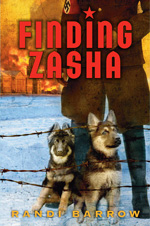 Twelve-year-old Ivan Savicheva and his mother have no choice but to take separate paths from their home in Leningrad in 1941. The Germans' continual bombing and blockade of the city have caused much food deprivation. When his mother is sent to another location to continue her factory work, Ivan cannot go with her and travels to his uncle's farm. Before he can reach the rural area, though, he stays with the family of his former neighbor and becomes involved in the partisan movement to fight against the Nazis. A chance encounter with Axel Recht, a cruel Nazi officer, and his two German shepherd puppies provides Ivan with the opportunity to spy on the Nazis. As he grows more attached to the puppies, Thor and Zasha, he hatches a plan to steal them from Recht. The author does a great job of capturing Ivan's experiences and describing little-known aspects of WWII from the point of view of the Russians. Readers will be able to feel the softness of the puppies’ fur as well as flinch from the sting of Recht's whip, wince at the puppies' initial training experience, savor the fresh vegetables Ivan and his new friends enjoy in the countryside, and dread Recht's promised revenge. Fans of Saving Zascha (Scholastic, 2011) will love this one, its prequel.
Twelve-year-old Ivan Savicheva and his mother have no choice but to take separate paths from their home in Leningrad in 1941. The Germans' continual bombing and blockade of the city have caused much food deprivation. When his mother is sent to another location to continue her factory work, Ivan cannot go with her and travels to his uncle's farm. Before he can reach the rural area, though, he stays with the family of his former neighbor and becomes involved in the partisan movement to fight against the Nazis. A chance encounter with Axel Recht, a cruel Nazi officer, and his two German shepherd puppies provides Ivan with the opportunity to spy on the Nazis. As he grows more attached to the puppies, Thor and Zasha, he hatches a plan to steal them from Recht. The author does a great job of capturing Ivan's experiences and describing little-known aspects of WWII from the point of view of the Russians. Readers will be able to feel the softness of the puppies’ fur as well as flinch from the sting of Recht's whip, wince at the puppies' initial training experience, savor the fresh vegetables Ivan and his new friends enjoy in the countryside, and dread Recht's promised revenge. Fans of Saving Zascha (Scholastic, 2011) will love this one, its prequel.
- Barbara A. Ward, Washington State University Pullman
James, Helen Foster & Virginia Shin-Mui Loh. (2013). Paper Son: Lee’s journey to America. Illus. by Wilson Ong. Ann Arbor, MI: Sleeping Bear Press.
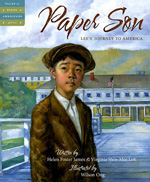 From the publisher’s Tales of Young Americans series, set in 1926, this is the story of orphaned Wang Lee. The twelve-year-old boy is living with his grandparents in rural China. His parents were killed by bandits just as they were making arrangements for their son to go to America on a “paper son slot” to find a better life. This meant they had purchased immigration papers from people already in America stating that they were related and so his new paper son name became Fu Lee. To get into the new land, the Gum Saan (Gold Mountain), Fu Lee had to be able to pass the entrance requirements at Angel Island, the immigration center in San Francisco for West Coast arrivals in the U.S. Fu Lee was studying his coaching book so that he would be prepared for the difficult examination from the immigration officials. This story is based on actual historical events and the concept of these young Chinese immigrants entering the U.S., spending time on Angel Island and meeting other new immigrants until finding their new life. Wilson Ong’s paintings add a beautiful and authentic background to the story. The author has included historical notes at the end and recommends the Angel Island Immigration Station, now a National Historic Landmark, for further information.
From the publisher’s Tales of Young Americans series, set in 1926, this is the story of orphaned Wang Lee. The twelve-year-old boy is living with his grandparents in rural China. His parents were killed by bandits just as they were making arrangements for their son to go to America on a “paper son slot” to find a better life. This meant they had purchased immigration papers from people already in America stating that they were related and so his new paper son name became Fu Lee. To get into the new land, the Gum Saan (Gold Mountain), Fu Lee had to be able to pass the entrance requirements at Angel Island, the immigration center in San Francisco for West Coast arrivals in the U.S. Fu Lee was studying his coaching book so that he would be prepared for the difficult examination from the immigration officials. This story is based on actual historical events and the concept of these young Chinese immigrants entering the U.S., spending time on Angel Island and meeting other new immigrants until finding their new life. Wilson Ong’s paintings add a beautiful and authentic background to the story. The author has included historical notes at the end and recommends the Angel Island Immigration Station, now a National Historic Landmark, for further information.
- Karen Hildebrand, Ohio Library and Reading Consultant
GRADES 9-12
Doeden, Matt. (2013). A marked man: The assassination of Malcolm X. Minneapolis:Twenty-first Century Books/ Lerner Publisher.
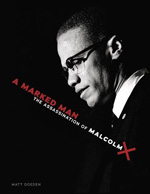 The life and death of civil rights leader, Malcolm X, has been shrouded with mixed reactions from groups of many different opinions and outlooks toward the 1960s era of civil rights. The first part of the book provides a biographical look at Malcolm Little and the circumstances of his troubled youth. While in prison, he learned about the Nation of Islam and became a follower. After his release he had changed from his more violent approach to civil rights and thus spoke out against the ways and means of the Nation of Islam. A charismatic speaker, Malcolm had followers listening to his new philosophy with interest, though Malcolm knew this put him in a dangerous position to speak against the NOI. The second part of the book explains what happened after his assassination on February 21, 1965, including the arrests of three men responsible, the court proceedings and consequent prison sentences but also goes on to ask many of the unanswered questions that seemed to surround this murder case. There were and continue to be questions concerning conspiracies and cover-ups from the police, investigators and other organizations to remain unanswered. Pair this book with Walter Dean Myer’s picture book biography, Malcolm X; A Fire Burning Brightly (HarperCollins, 2000) to introduce this civil rights leader.
The life and death of civil rights leader, Malcolm X, has been shrouded with mixed reactions from groups of many different opinions and outlooks toward the 1960s era of civil rights. The first part of the book provides a biographical look at Malcolm Little and the circumstances of his troubled youth. While in prison, he learned about the Nation of Islam and became a follower. After his release he had changed from his more violent approach to civil rights and thus spoke out against the ways and means of the Nation of Islam. A charismatic speaker, Malcolm had followers listening to his new philosophy with interest, though Malcolm knew this put him in a dangerous position to speak against the NOI. The second part of the book explains what happened after his assassination on February 21, 1965, including the arrests of three men responsible, the court proceedings and consequent prison sentences but also goes on to ask many of the unanswered questions that seemed to surround this murder case. There were and continue to be questions concerning conspiracies and cover-ups from the police, investigators and other organizations to remain unanswered. Pair this book with Walter Dean Myer’s picture book biography, Malcolm X; A Fire Burning Brightly (HarperCollins, 2000) to introduce this civil rights leader.
- Karen Hildebrand, Ohio Library and Reading Consultant
Padian, Maria. (2013). Out of nowhere. New York: Knopf.
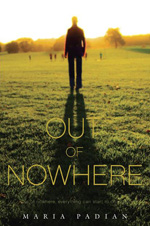 Based on a real event, the story opens with Tom Bouchard’s senior year at Maquoit High School in Enniston, Maine. Tom is enjoying his life as captain of the soccer team, having a hot girlfriend and in great standing with grades and opportunities for college. In the meantime, Enniston has become a “secondary migration” location for Somali refugee families. Through a series of events including Tom’s sentenced community service at the local community center he becomes a tutor for some of the new Somali students. He gets to know Saeed and recruits him for the soccer team where he quickly discovers Saeed’s amazing soccer talents. Very soon after the soccer team launches into an outstanding season complete with the fan following and media attention. However, not everyone in the community is pleased to see the Somali players get this praise, and consequently, the racism and prejudices that have been lurking beneath still waters flood into the public arena. Read about the background to this fact-based novel and how the author was inspired to write about this actual incident in Lewiston, Maine.
Based on a real event, the story opens with Tom Bouchard’s senior year at Maquoit High School in Enniston, Maine. Tom is enjoying his life as captain of the soccer team, having a hot girlfriend and in great standing with grades and opportunities for college. In the meantime, Enniston has become a “secondary migration” location for Somali refugee families. Through a series of events including Tom’s sentenced community service at the local community center he becomes a tutor for some of the new Somali students. He gets to know Saeed and recruits him for the soccer team where he quickly discovers Saeed’s amazing soccer talents. Very soon after the soccer team launches into an outstanding season complete with the fan following and media attention. However, not everyone in the community is pleased to see the Somali players get this praise, and consequently, the racism and prejudices that have been lurking beneath still waters flood into the public arena. Read about the background to this fact-based novel and how the author was inspired to write about this actual incident in Lewiston, Maine.
- Karen Hildebrand, Ohio Library and Reading Consultant
These reviews are submitted by members of the International Reading Association's Children's Literature and Reading Special Interest Group (CL/R SIG) and are published weekly on Reading Today Online. The International Reading Association partners with the National Council of Teachers of English and Verizon Thinkfinity to produce ReadWriteThink.org, a website devoted to providing literacy instruction and interactive resources for grades K–12.